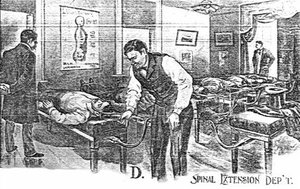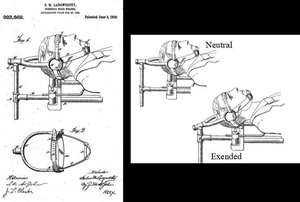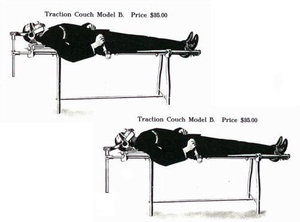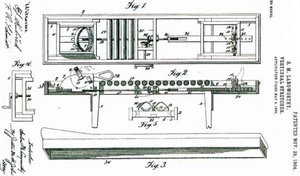History teaches that a Presbyterian minister, Samuel Weed, coined the name for the profession of chiropractic from the Greek cheir for "hand" and praktos for "done."1 Although the chiropractic profession was founded on the principle of "by hand only" adjustments for the correction of the chiropractic lesion, mechanical devices to aid in the correction or reduction of spinal subluxations have existed in chiropractic since the early days of the profession.
But what is the origin of corrective traction in the chiropractic profession, and who is responsible for injecting mechanical methods into a profession whose name suggests a strictly manual approach?
A Stipulation
Traction in the management of spinal conditions dates back as far as the time of Hippocrates.2 The word itself is derived from the Latin tractico, which means a process of pulling apart.
Since traction has been used for millennia to treat spinal ailments, I suggest that for anyone in chiropractic to be ordained as the "Father of Corrective Traction" in chiropractic, the intent of said traction must necessarily be for the specific purpose of correcting or reducing the chiropractic lesion of vertebral subluxation. With that stipulation established, let's look at the evidence.
 Figure 1. Storey's use of "The Hanging Cure." Illustration courtesy Chiropractic History and the Association for the History of Chiropractic.
Thomas Story
Figure 1. Storey's use of "The Hanging Cure." Illustration courtesy Chiropractic History and the Association for the History of Chiropractic.
Thomas Story
Thomas Storey was one of the earliest graduates of the Palmer School of Chiropractic. Prior to studying under Old Dad Chiro, Storey obtained an osteopathic degree. Storey was probably the first person with a chiropractic degree to employ mechanical traction. His use of traction was a commonly employed orthopedic treatment around the turn of the 20th century known as "the Hanging Cure" (Figure 1).
Although the first person with a chiropractic degree to employ mechanical traction, there is no documentary evidence yet discovered that Storey's intent was to use the method to reduce the chiropractic subluxation. He invented no unique devices and merely employed an accepted medical modality of the era as intended by allopathic physicians. Storey is clearly not the "Father of Corrective Traction" in chiropractic.
Solon Massey Langworthy
Solon Langworthy was among the first 10 graduates of the Palmer School.4 Like Thomas Storey before him, Langworthy also had studied osteopathy prior to studying under Old Dad Chiro. Perhaps due to the influence of their prior training, both Storey and Langworthy did not see a problem with using mechanical devices in the treatment of patients.
 Figure 2. Langworthy's spinal extension department from his personal practice in Cedar Rapids, Iowa, and his American School of Chiropractic and Nature Cure. Illustration courtesy the author's private collection.
Langworthy, however, invented unique devices and reasoned that sustained forces applied via traction was the only effective manner to reduce some types of vertebral subluxations. In 1904, he wrote that as individuals aged, the intervertebral discs narrow as a result of exposure to constant gravitational pressure. He further stated that this loss of disc height would eventually lead to the narrowing of the intervertebral foramina, which he referred to as "spinal windows."
Figure 2. Langworthy's spinal extension department from his personal practice in Cedar Rapids, Iowa, and his American School of Chiropractic and Nature Cure. Illustration courtesy the author's private collection.
Langworthy, however, invented unique devices and reasoned that sustained forces applied via traction was the only effective manner to reduce some types of vertebral subluxations. In 1904, he wrote that as individuals aged, the intervertebral discs narrow as a result of exposure to constant gravitational pressure. He further stated that this loss of disc height would eventually lead to the narrowing of the intervertebral foramina, which he referred to as "spinal windows."
The only means by which to reverse this condition – which he referred to as "vertical subluxation" – was by the application of specific, sustained forces applied with the use of spinal traction devices.5 Figure 2 illustrates Langworthy's "Spinal Extension Department" from his early 19th-century clinic and American School of Chiropractic.
 Figure 3. Langworthy's unique head holder that allowed many different traction positions of the head in relation to the thorax. From the patent: "B is an extension rod adapted to be moved endwise by suitable mechanism, not shown. To the head of this is attached a standard C, adjustable up an down in the head by means of a set-screw D."7 The illustration on the right demonstrates the device with the head in the neutral position and in the extended position. Illustrations courtesy the author's private collection.
In addition to vertical subluxations, Langworthy and his colleagues also discussed anterior and posterior subluxations of the vertebrae, as well as lordotic and kyphotic subluxations of the spine.6 To reduce some of these particular subluxation configurations, Langworthy invented and patented several devices designed to achieve those corrections.
Figure 3. Langworthy's unique head holder that allowed many different traction positions of the head in relation to the thorax. From the patent: "B is an extension rod adapted to be moved endwise by suitable mechanism, not shown. To the head of this is attached a standard C, adjustable up an down in the head by means of a set-screw D."7 The illustration on the right demonstrates the device with the head in the neutral position and in the extended position. Illustrations courtesy the author's private collection.
In addition to vertical subluxations, Langworthy and his colleagues also discussed anterior and posterior subluxations of the vertebrae, as well as lordotic and kyphotic subluxations of the spine.6 To reduce some of these particular subluxation configurations, Langworthy invented and patented several devices designed to achieve those corrections.
The first device was described as a "surgical head holder."7 The device is depicted in Figure 3 and was attached to a number of Langworthy's traction devices.
As you can see, the versatility of the device could allow for multiple positions for providing traction forces that could correct the many subluxation configurations Langworthy and his associates described in their writings.6,8 In the catalogue of his inventions, he states:
The new head pull is a distinctive feature. It may be raised or lowered as desired. It may be rotated to either side and locked at any point or angle. The head harness is so arranged that the pull is divided equally between the three points, forehead, chin and occiput.9
 Figure 4
Figure 4 illustrates the Model B version of one of his traction devices in the neutral and extension positions. As described above, traction could also be accomplished in flexion and axial rotation positions.
Figure 4
Figure 4 illustrates the Model B version of one of his traction devices in the neutral and extension positions. As described above, traction could also be accomplished in flexion and axial rotation positions.
As additional evidence of the utility of these devices in correcting kyphotic and anterior subluxations of the cervical vertebrae, a case report is presented in volume II of the Langworthy published text, Modernized Chiropractic:8
The jaw prevents any of the manual contacts from coming in contact with the anterior part of the atlas, and for this reason a posterior thrust cannot be employed in the correction of an anterior subluxation of the atlas in the same way that an anterior thrust is used in the correction of posterior subluxations of the atlas.
Specially applied traction is the most efficacious method of correcting an anterior subluxation of the atlas. The patient should be placed on the traction table venter up, the strap which passes over the forehead should be adjusted so that the head will be thrown backward on the atlas. When the pull occurs on the head by means of the strap and the one which passes beneath the occiput, the tendency is for the condyles on the occiput to move forward on the superior articular surfaces of the atlas. This is equivalent to the atlas moving backward on the occiput.
 Figure 5. The Langworthy Vertebral Stretcher patent. Illustration courtesy the author's personal collection.
Figure 5. The Langworthy Vertebral Stretcher patent. Illustration courtesy the author's personal collection.
"In Figs. 2 and 4 is shown a device by which the body of a patient may be drawn sidewise or upward at any desired angle, while under longitudinal tension. In suitable slides 38 running on guide-rails 39 attached to the top of the frame, is adjustably mounted a semi-circular yoke 40, the elevation of which may be varied at pleasure. On the yoke is adjustably mounted a slide 41, and through this runs a screw 42 movable by hand wheel 43. Through the center of this screw, which is tubular, runs a hooked rod 44, headed at 45, but free to turn in the screw. The hook takes a strap 46, which may pass around the body or a limb at any point, as the apparatus may be slid from end to end of the main frame. The adjustment of the slide 41 makes it possible to apply the lateral stress at any desired angle, a downward lateral pull not being required."11
The straps on the traction table which engage the head are adjustable so that the head may be placed at the desired angle with the neck. The following illustration is a practical example of a case in which this special form of traction brought about the necessary change in position of the bones of the upper cervical group after other methods had failed.
Case V. The left ear had been afflicted with a stopped up feeling for some time, when the right ear began to be affected in quite the same way. The case was one of occlusion of the Eustacian tubes from local inflammation, due, of course, to nerve disturbance from the malposition of the upper cervical vertebrae. Two treatments of fifteen minutes each by neck traction with the head held well backward by the strap, cured the trouble entirely."8 (Author's emphasis)
Langworthy's Thoracolumbar Traction Devices
The thoracolumbar spine received address by the Langworthy genius, too. He received a patent in 1904 for his "Vertebral Stretcher," which was aimed at reducing vertical subluxations. In the patent, Langworthy states:
This invention relates to the treatment of the vertebral column for affections peculiar to it, and more particularly distortions or compression of the intervertebral cartilages.
The object of the invention is to provide simple, convenient, and easily-operated mechanism whereby the vertebral column may be stretched or extended and kept in that position so long as circumstances may require with a view to relieving pathological conditions due to abnormal or natural compression of the cartilages and the possible restoration of the subject to health and strength."10
Figure 5 is one of the illustrations from Langworthy's patent.
 Figure 6
Finally, in 1908 Langworthy received a patent on his device that would become known as the "Amplia Thrill" traction table.11 Illustrations from the patent are included in Figure 6. The device had a unique semicircular yoke that could be moved along the longitudinal arch of the table. A slide was attached to the yoke that could be moved along the yoke and a girth (as in the girth of a horse's saddle) hanging from the slide could encircle a supine patient's body.
Figure 6
Finally, in 1908 Langworthy received a patent on his device that would become known as the "Amplia Thrill" traction table.11 Illustrations from the patent are included in Figure 6. The device had a unique semicircular yoke that could be moved along the longitudinal arch of the table. A slide was attached to the yoke that could be moved along the yoke and a girth (as in the girth of a horse's saddle) hanging from the slide could encircle a supine patient's body.
By turning the tubular screw to which the girth was attached, the patient's spine could be pulled into extension, or some combination of extension and lateral bending, with the spine simultaneously under longitudinal traction.
 Figure 7
Figure 7 is a photograph from Langworthy's catalogue of the Amplia Thrill,12 demonstrating a patient in the device with the yoke and girth applying slight extension traction at the thoracolumbar region.
Figure 7
Figure 7 is a photograph from Langworthy's catalogue of the Amplia Thrill,12 demonstrating a patient in the device with the yoke and girth applying slight extension traction at the thoracolumbar region.
Ending the Speculation
Res ipsa loquitur literally means, "The thing speaks for itself." The words represent a legal concept that the circumstances are so obvious that the burden of proof has been utterly met and no further evidence need be presented. Res ipsa loquitur certainly applies here, as the evidence is overwhelming – despite modern attempts to give credit to others13 – that Solon Massey Langworthy is the "Father of Corrective Traction" in chiropractic.
Editor's Note: The Association for the History of Chiropractic (AHC) has preserved the credible history of the profession as its sole mission through the publication of the scholarly journal, Chiropractic History. Stories such as this one may be accessed through the pages of the AHC's journal (www.historyofchiropractic.org). Complete references cited in this article can be accessed by clicking here.
Dr. Steve Troyanovich is the secretary of the Association for the History of Chiropractic. Contact him with questions and comments at
. The AHC has preserved the credible history of the profession as its sole mission through the publication of the scholarly journal, Chiropractic History. Stories such as this one may be accessed through the pages of the AHC's journal (www.historyofchiropractic.org).




